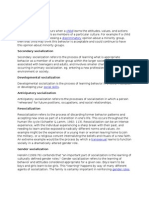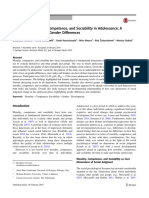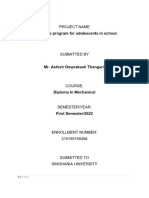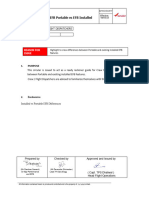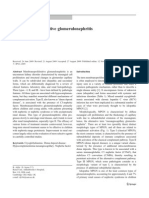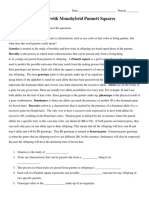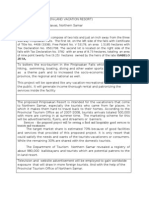Youth Sense of Community Voice and Power in Commun
Youth Sense of Community Voice and Power in Commun
Uploaded by
madeehanfqadriCopyright:
Available Formats
Youth Sense of Community Voice and Power in Commun
Youth Sense of Community Voice and Power in Commun
Uploaded by
madeehanfqadriOriginal Title
Copyright
Available Formats
Share this document
Did you find this document useful?
Is this content inappropriate?
Copyright:
Available Formats
Youth Sense of Community Voice and Power in Commun
Youth Sense of Community Voice and Power in Commun
Uploaded by
madeehanfqadriCopyright:
Available Formats
See discussions, stats, and author profiles for this publication at: https://www.researchgate.
net/publication/230144145
Youth sense of community: Voice and power in community
contexts
Article in Journal of Community Psychology · August 2007
DOI: 10.1002/jcop.20173
CITATIONS READS
150 2,613
1 author:
Scotney D Evans
University of Miami
43 PUBLICATIONS 745 CITATIONS
SEE PROFILE
All content following this page was uploaded by Scotney D Evans on 18 November 2018.
The user has requested enhancement of the downloaded file.
A R T I C L E
YOUTH SENSE OF COMMUNITY:
VOICE AND POWER IN
COMMUNITY CONTEXTS
Scot D. Evans
Wilfrid Laurier University
䡲
Sense of Community theory suggests that people feel more attracted to
groups and settings in which they feel influential or powerful.
Unfortunately, young people have no voice or influence in many of the
contexts in which they find themselves. Furthermore, teenagers are often
unequipped and undersupported to participate fully and feel like they are
making meaningful contributions to society. This is especially the case for
young people who are disadvantaged or members of a minority groups. A
two-part study was undertaken to explore sense of community in
adolescents. The first phase utilized existing tools to measure adolescent
sense of community in school, neighborhood, and city contexts. The second
phase of the study relied on in-depth interviews with teenagers to better
understand how they construct their sense of community. This article
reports findings from the second phase and looks closely at the sense of
community domain of “influence” as it applies to adolescents. Interviews
with young people suggest that they feel a stronger self-described sense of
community in contexts where they experience voice and resonance, some
power and influence, and adequate adult support and challenge. © 2007
Wiley Periodicals, Inc.
INTRODUCTION
Research in the area of adolescent development clearly suggests that young people
benefit in myriad ways from opportunities to be involved in community ~Catalano,
Loeber, & McKinney, 1999; Maton, 1990; Youniss, McLellan, & Yates, 1997!. However,
much of the research on sense of community ~SOC!, social cohesion, and social
capital has neglected to capture the experiences of adolescents ~Edwards, Foley, &
Diani, 2001; McMillan & Chavis, 1986; Perkins & Long, 2002; Putnam, 2000; Sarason,
1974!. This study explores young people’s experience in these community settings and
Correspondence to: Scot D. Evans, Department of Psychology, Wilfrid Laurier University, 75 University
Avenue West, Waterloo, Ontario, N2L 3C5, Canada. E-mail: sevans@wlu.ca
JOURNAL OF COMMUNITY PSYCHOLOGY, Vol. 35, No. 6, 693–709 (2007)
Published online in Wiley InterScience (www.interscience.wiley.com).
© 2007 Wiley Periodicals, Inc. DOI: 10.1002/jcop.20173
694 • Journal of Community Psychology, August 2007
attempts to better understand the features and characteristics of experiences in those
settings that foster positive development of SOC. The main goal of this study is to see
how community opportunities increase teenagers’ SOC in various settings and what
elements of these opportunities have the greatest potential for connecting young
people to community.
SENSE OF COMMUNITY AND ADOLESCENCE
Researchers have suggested that SOC theory has relevance to the teenage population
but have concerns about measurement of this construct in teenagers using adult tools
~Chipuer & Pretty, 1999; Pretty, Conroy, Dugay, Fowler, & Williams, 1996!. It is impor-
tant to understand that adolescents may perceive community in quite different ways
than adults. Therefore, the tools used to assess sense of community need to reflect
this difference. In adolescence, young people are just beginning to reflect on their
place in these larger contexts. This review of the literature will connect SOC with
these developmental concerns.
Development and Adolescence
Developmental psychology has much to offer towards our understanding of contextual
influences on the healthy development of adolescents. Theories of life–span human
development suggest that it is the interactive influences of genetic traits and environ-
mental conditions that result in behavior and personality change. With changing
conditions in neighborhoods, schools, communities, and the larger society, it is impor-
tant to look at the developmental needs of adolescents and how these systems either
promote or hinder the meeting of these needs.
In the psychosocial domain, theories focus on the adolescent’s developmental
need for the formulation of a personal and social identity ~Erikson, 1968; Marcia,
1993!, self-concept ~Yates & Youniss, 1998!, and personal efficacy ~Bandura, 1997!.
Erikson believed that the process of consolidating a personal identity is grounded in
relationships and through an understanding of society, emphasizing the social nature
of development. Vygotsky ~1978!, although technically a cognitive developmentalist,
stressed the sociocultural context of development and the importance of social inter-
action with more advanced peers and adults. Other developmental researchers have
found that identity formation and well-being during adolescence consist of integrative
issues where adults, peers, and opportunities for exploration play key roles ~Adamson,
Hartman, & Lyxell, 1999; Grotevant, 1997; Marcia, 1980; Maton, 1990; Pretty, 2002!.
Interviews with young people conducted by Grace Pretty and colleagues found that
their responses “imply identity of self with respect to the community ~p. 7!”.
Cognitive developmental theories focus on making meaning from experience.
Most cognitive theorists are grounded in the work of Piaget ~1971!, who categorized
development as the ongoing process of organizing and adapting to experience. Theo-
ries of ego development ~Loevinger & Blasi, 1976!, constructive development ~Kegan,
1982, 1994!, and moral and social development ~Gilligan, 1982; Kohlberg, 1976; Piaget,
1965; Selman, 1977! suggest an ever increasing capacity for complex and abstract
thought and sense of obligation for others as adolescence progresses, and a increasing
sensitivity to community and its claims upon the citizen ~Adelson & O’Neil, 1966!.
Journal of Community Psychology DOI 10.10020jcop
Voice and Power in Community Contexts • 695
Adolescents emerge from an embeddedness in needs and begin to develop the capac-
ity for mutuality, empathy, and reciprocal obligation ~Kegan, Noam, & Rogers, 1982!.
In addition, with increase in age and cognitive capacity, moral reasoning becomes
more integrated in the political-cultural domain ~Raaijmakers, Verbogt, & Vollebergh,
1998!. As with the psychosocial theories of development, cognitive theories stress the
importance of contexts for development ~Bronfenbrenner, 1998; Crockett & Crouter,
1995; Vygotsky, 1978! as well as social and group interaction ~D’Andrea & Daniels;
Kegan! and adult support and guidance ~Selman; Vygotsky!.
Adolescent Psychological Sense of Community
Adelson and O’Neil ~1966! were the first researchers to use the “Sense of Community”
description with adolescents, and they did so years before Sarason ~1974; 1986! described
Psychological Sense of Community ~PSOC! as the feeling that one is part of a readily
available, supportive, and dependable structure. McMillan and Chavis ~1986! sub-
divided SOC into four categories: membership, influence, integration and fulfillment
of needs, and shared emotional connection. Researchers have supported the rele-
vance of SOC to adolescents ~Pretty, 2002!, have shown SOC to be a catalyst for civic
participation ~Chavis & Wandersman, 1990!, and important for positive social devel-
opment ~Connell, Halpern-Felsher, Clifford, & Crichlow, 1995! and well-being ~Pretty
et al., 1996!.
There is, however, little consensus on the psychological dimensions that underlie
SOC ~Buckner, 1988; Chavis, Hogge, McMillan, & Wandersman, 1986; Chavis & Pretty,
1999; Chipuer & Pretty, 1999; McMillan & Chavis, 1986; Long & Perkins, 2003!. Chipuer
and Pretty ~1992! in their review of the Sense of Community Index ~SCI!, suggest that
basing measurement of SOC on the theoretical work of McMillan and Chavis is a
promising frame for the development of this construct, but previous attempts at factor
analysis have revealed little support for the four dimensions theorized by these authors
~Chipuer & Pretty, 1999; 1986; Long & Perkins, 2003!. Chipuer and Pretty ~1999!
report acceptable reliability for the SCI, but they found that the reliability estimates of
each of the subscales are unacceptably low. Long & Perkins ~2003! report similar
problems with the measurement of SOC with the SCI, and they have proposed a
three-factor model based on social connections, mutual concerns, and community
values. Both studies suggest the strongest support for the “membership” subscale.
Although the 12-item Sense of Community Index ~SCI! was developed from a
longer measurement tool to measure this phenomenon in adults ~Chavis et al., 1986!,
there is some concern for the appropriateness of this tool with adolescent populations
and its tendency to miss constructs important to teenagers such as fun and safety
~Chipuer et al., 1999; Chipuer & Pretty, 1999; Patten, 2000!. Pretty and collegues
~Pretty, Andrewes, & Collett, 1994! applaud the inclusion of youth in community
research and suggest that SOC can be helpful in understanding adolescent develop-
mental processes. They also have found that SOC in adolescents can differ across
settings.
Research on SOC in adults in neighborhood settings has found that it positively
relates to neighboring, collective efficacy, and participation in grassroots community
based organizations ~Long & Perkins, 2003!. In youth, SOC correlated with length of
residence, number of supports, satisfaction with supports, and nondirective support
~Pretty et al., 1994!. Younger adolescents tend to have a stronger neighborhood SOC
implying that as teens age, they congregate in areas away from neighborhood and thus
Journal of Community Psychology DOI 10.10020jcop
696 • Journal of Community Psychology, August 2007
feel less connected and have less opportunities to influence the neighborhood. This
concerns Chipuer and Pretty ~1999!, who worry that less opportunity to affect the
neighborhood may lead to apathy and lack of community engagement.
In the school context, PSOC in the classroom is an important factor in students’
social skills and social behavior in the classroom setting ~Bateman, 1998; Goodenow,
1993!. Pretty and colleagues ~Pretty et al., 1994; Pretty et al., 1996! found that younger
adolescents have stronger school SOC and that it is not related to length of atten-
dance at a particular school. In addition, they found that lack of school SOC is a
significant predictor of adolescent loneliness ~Pretty et al., 1994!. There is some indi-
cation that a strong sense of school community and student solidarity can act as a
formative component of public interest as a life goal for youth ~Flanagan, Bowes,
Jonsson, Csapo, & Sheblanova, 1998!.
Civic and Political Identity
In their introduction to a special issue of the Journal of Social Issues focused on youth,
Flanagan and Sherrod ~1998! indicate renewed interest in the political development
of young people. Research suggests that the drive to integrate with society is a devel-
opmental need of adolescence and that political views also develop in concert with
identity ~Flanagan et al., 1998; Flanagan & Tucker, 1999; Grotevant, 1993, 1997!.
Flanagan and colleagues found that family environment is a contributing factor to the
development of civic identity and suggest that adolescents were more likely to con-
sider public interest an important life goal when their families emphasized an ethic of
social responsibility ~Flanagan et al., 1998!. Youth from privileged backgrounds show
greater awareness of social issues ~Flanagan & Tucker, 1999!. Although some effort has
been made to assess the development of political or civic identity, social responsibility
~Berman, 1997!, and moral development ~Power, Higgins, & Kohlberg, 1989!, these
studies tend to neglect the community-focused attitudes. In addition, when commu-
nity does enter into the discussion, it tends to focus more on structured programs or
volunteering as the context rather than characteristics of the community setting itself.
Benefits of Community Involvement and Community Service
The most extensive research on adolescent community involvement has been con-
ducted by Miranda Yates and James Youniss ~1996, 1997, 1998!. These researchers and
others report various benefits of community involvement and community service rang-
ing from prosocial development and self-efficacy ~Dryfoos, 1990; Scales, Blyth, Berkas,
& Kielsmeier, 2000; Scales & Leffert, 1999; Yates & Youniss, 1996; Youniss, McLellan,
Su, & Yates, 1999!, to moral-political awareness, civic identity, and political identity
~Yates & Youniss, 1996; Youniss et al., 1997; Youniss & Yates, 1997!. The National
Longitudinal Survey of Youth reports a much higher likelihood of dropping out in
teens who did not participate in community service activities ~as cited in Youniss &
Yates, 1997!. In tracking the benefits over time, researchers have found that commu-
nity participation in adolescence correlates positively with moral-civic activism and
positive outcomes in adulthood ~Youniss & Yates, 1999!.
Paradoxically, young people from less privileged homes are least likely to have
access to these meaningful opportunities because of financial and transportation con-
straints ~Hart, Atkins, & Ford, 1998; Newman, Fox, Flynn, & Christeson, 2000!. Yet,
developmentally, they may have the most need and much to offer ~Brendtro, 1985!.
Journal of Community Psychology DOI 10.10020jcop
Voice and Power in Community Contexts • 697
If what makes communities strong are collections of people who feel connected,
responsible, supported, and influential, then we should make considerable effort to
create environments for and with young people that promote the development of
these characteristics. Too often young people get excluded from matters of commu-
nity yet are expected to behave in ways that are respectful, caring, and responsible
to community. In addition, those young people who do get opportunities to be involved
in community are often from privileged families, leaving out those who could most
benefit from feeling a sense of belonging and purpose. This study is an attempt to
get to the heart of young people’s experience of community, their development of
a self-in-community identity, and their connection to community in order to better
understand how neighborhoods, school communities, community organizations,
and the community-at-large can better support the positive development of young
citizens.
STUDY DESIGN
Participants
In-depth interviews were conducted with 17 teenagers ranging in age from 15 to 18.
Five of the 17 were participants in leadership program for young people. This
program, run by a Nashville-based youth serving agency, selects 40 high school soph-
omores each year to be part of the program that meets once a month for 9 months.
During the program selection process, the organization made efforts to select a class
that is representative of the adolescent population in Nashville with equal dis-
tribution of males and females and diversity in other areas. The host organization of
this program is an independent non-profit that has been providing services and
opportunities for youth and families in Nashville for over 36 years. The 5 partici-
pants were selected for in-depth interviews based on a range of mean scores on SOC
survey instruments administered during phase 1 of the study. Two males and three
females from this program participated in the interviews. All were high school
sophomores.
Twelve young people from another youth development program also participated
in this phase of the study. This group consisted of African American students ages
15–18 from low-income areas in East Nashville. These students were interviewed at the
end of their summer program, after they participated in community research and
action activities. The host organization for this program is a small youth organizing
agency that works primarily with youth from low-income families in Nashville. They
have been in operation for less than 5 years.
Additionally, journal entries on SOC were collected from the 40 participants in
the youth leadership program to help triangulate themes that emerged from the
interviews. These written pieces are described in the next section. All participants
contacted for involvement in the study had the opportunity to refuse participation, and
because most participants were under the age of 18, parent or guardian permission for
participation was required
This study utilized a convenience sample of young people in Nashville and no
claims are made here as to statistical generalization of results ~Yin, 2003!. The goal of
this portion of the study is to expand and generalize theory, and the reader should use
this lens as he or she walks through the narratives and subsequent discussion.
Journal of Community Psychology DOI 10.10020jcop
698 • Journal of Community Psychology, August 2007
CONDUCTING THE STUDY
Student Writings
The 40 participants from the youth leadership program participated in an early pro-
gram session in which they were asked to write responses to three questions:
1. Think of something that you have recently been involved in that made you feel
what you believe is a “sense of community.”
2. How would you describe that feeling of a sense of community?
3. This experience of sense of community came about because. . .
Responses were collected and prepared for analysis.
Participant Interviews
One-with-one interviews with young people took place on site at the host organization
of the program in which the teens were participating. Interviews began with open-
ended questions, such as “tell me what it is like for you in your neighborhood,” that
allow young people to talk about what is important to them. Follow-up questions were
focused on hearing their stories of experiences about what they considered a sense of
community to be. Interviews were recorded and transcribed for later analysis.
Program Observation
In order to understand better the program and organizational contexts, I spent time
in both programs observing program activities and following staff communications
and reviewing agendas for program sessions.
Analysis
All transcribed interviews, field notes, and students’ written responses were coded
utilizing a constant comparative method with the qualitative software application NVivo.
After collecting student-written responses to the general questions and notes of two
depth interviews, I did a first round of coding with two interviews that resulted in the
creation of three general categories: ~a! “affective SOC”—how young people describe
the feeling of SOC; ~b! “SOC experiences”—those experiences, events, and inter-
actions that lead to feeling SOC; and ~c! “SOC contexts”—those places or structures in
which the experiences took place. From there, I developed properties within those
categories based on respondent narratives. I then went through the remaining inter-
views to see how the data matched the created categories and properties and created
new properties as needed.
Early in the coding process, themes around young people’s experiences of voice
and influence in these contexts began to emerge. At this point, I used the initial three
categories to help make distinctions among feelings, experiences, and settings. To
explore the themes of voice and influence more deeply, I focused my questions in
these areas during the second round of interviews with students in the second pro-
gram. At this point, I employed the services of a peer debriefer to help check my
coding against the raw data to support the credibility of my analysis. I also presented
my tentative analysis of the qualitative data to the staff of the two programs for
Journal of Community Psychology DOI 10.10020jcop
Voice and Power in Community Contexts • 699
feedback on the topic of voice and influence as an important area to explore. The
peer reviewer and the staff at both programs supported this direction for the analysis.
FINDINGS AND DISCUSSION
My interviews with teenagers suggest that young people feel a stronger self-described
sense of community in contexts in which they experience voice and resonance, some
power and influence, and adequate adult support and challenge. The ability and opportu-
nity to play a meaningful role in settings and the ability to influence the course of
events help young people feel connected and powerful. Young people feel a stronger
SOC for contexts to which they feel responsible—they want and need to play a role.
When they were asked by adults to contribute, there was an automatic effect of “draw-
ing in” the young person to that context. When young people felt heard, they felt like
an integral part of that community. Time after time in these interviews when young
people were telling stories of feeling valued and heard in contexts, their narratives
became animated and energetic as they described how good it felt to be heard. It also
became apparent that in order to feel powerful in these contexts, young people
benefited from opportunities to build social competence. Additionally, the chance to
put these new knowledge and skills into action with adequate adult support contrib-
uted to their empowerment.
Identification of these three main themes involved an inductive, subjective process
grounded in my formal and informal conversations with teenagers and my experience
with the two youth programs. Although many different themes emerged from these
conversations, these three were consistently present across interviews. Specifically, I
will discuss, voice and resonance, power and influence, and adult support and challenge and
illustrate each theme with some of the young people’s narratives.
Voice & Resonance
In describing experiences where they felt a SOC, many young people talked of times
when they felt like they had a say in a community setting. Many connected their
experience of SOC to times when they were asked to participate, to contribute in
some way in a school or organization. Here, a young person is describing an experi-
ence working in a local community organization:
Yeah, like when we were at meetings, they always asked our opinion. That
was kind of fun being able to give your opinion when you have only been
there a month. I thought that was great. They really wanted a youth opinion,
they wanted a youth voice. All they have is adult people there and a couple
of youth. Here, me and my partner came and we gave it to them and they
liked it.
Another young person describes feeling important in a church community because
of the role that she and other youth can play in decision making:
The youth are very involved in our church. Our church is really youth-based
and I feel like we are important in making decisions.
Journal of Community Psychology DOI 10.10020jcop
700 • Journal of Community Psychology, August 2007
And another young person describes feeling a SOC in working together with his
peers on a project in a youth program and finding a place for his voice:
With the project, we all give ideas and we are all working toward one specific
thing. If I want things done the way that I think would benefit everyone else,
then I should say it because if I don’t say it then it might not be done.
Young people spoke of embracing the opportunities to contribute their voice in a
variety of settings, telling me that they appreciate these opportunities and want to
feel like a contributing member of the community. These opportunities, it seems,
appear to be reinforcing in that the more they experience the opportunities in which
to have a voice, the more they find their voice and want to continue to contribute.
They also begin to see how much value their voice can have for the community.
Like when we did the forum with the ~metro! council people. To sit down and
talk with them, and to have the opportunity to help someone understand. The
youth really have an opinion. To go to Washington . . . people want to hear
our opinions. I think we have a say so in everything we want to do.
An opportunity to have a voice in contexts also builds young people’s identity as
a relative equal in the community and helps develop an expectation for active par-
ticipation as the norm.
It makes you feel like a person, like you are an equal. Teens can have a good
idea or an opinion and it is important. Adults need to know. It’s important to
have a say so ‘cause we are the ones who will be in charge soon. Come on now,
it’s our turn.
They had a particularly positive reaction when they felt as if adults heard and
responded to their concerns. The experience of voice in certain contexts is similar to
the concept of resonance described by Carol Gilligan ~1982!. For young people to fully
experience voice, it requires resonance—some signal that their contributions are being
heard and actively considered. Some youth seemed a little surprised that adults in
these contexts actually created this space, responded to their voice, and acted on
suggestions. When their voice found resonance in these community contexts, it helped
young people feel as if they mattered, as if they belonged. One young woman describes
her surprise when she was asked her opinion on activities at a community center:
At that lock-in thing, they really did listen to what I thought we should do
when we were planning. I suggested a whole lot of games and things and they
~adults! really did listen. They really did listen to me. When we would go on
trips and things I would suggest things and they would listen.
Another young person describes her surprise when the executive director of an
agency was asking for and responding to feedback about a community program:
And when we started to tell her stuff, everybody else started chiming in about
how to make the program better. Her asking was like wow, we really have
something to say, she really is taking it into consideration, and not pushing it away.
She was just listening and said “I’m gonna call you at home.” We’re important!
Journal of Community Psychology DOI 10.10020jcop
Voice and Power in Community Contexts • 701
Having a voice in the community matters to young people and it helps pull them
into community. And when that voice meets with resonance and has an impact in
settings, young people fulfill their potential to have an influence.
Power & Inf luence
Opportunities in which to contribute and have an influence on community contexts
can help a young person feel powerful. It is important to understand, however, that in
order to have real power in any of these contexts, young people need a combination
of agency ~ability! and structure ~opportunity! to influence a course of events ~Nelson
& Prilleltensky, 2005!. As Stephanie Riger ~1993! suggests, power is control and mas-
tery. To feel empowered, young people need the skills to feel efficacious in these
contexts and they need limited barriers and ample opportunities to put these skills
into action.
Programs in which the interviews took part were aimed at developing the critical
skills, knowledge, and confidence of young people while giving them opportunities to
try out their abilities in community contexts. These opportunities have the potential
to enhance sociopolitical development and personal and political efficacy. Ultimately,
successful youth development programs create young citizens who can act as partici-
pants, catalysts, or agents of change in the community: powerful young people. These
results are more likely when youth have the opportunity to learn new skills and
knowledge in “real time” in a supportive and challenging environment. To take advan-
tage of opportunities to use their voice in the community, young people need the
capacity and confidence to do so.
This theme bears some similarity to the “opportunity role structure” characteristic
of empowering settings suggested by Maton and Salem ~1995!. As they suggest, oppor-
tunity role structures provide “meaningful opportunities for individuals to develop,
grow, and participate” ~p. 643!. Here, power comes not just from participation but also
from opportunities to develop the necessary skills and competencies in order to be
able to have real influence in settings. Young people need both to feel powerful and
influential.
Especially at the city level, many young people reported feeling overwhelmed by
the task of being an active contributor, reflecting the need for new skills and more
support: “I don’t know enough about the city to even begin to get involved in issues.
I was given a month to work on the project and that was all I could come up with.”
When asked about their role in the larger community, young people often spoke of
feeling “small” and “insignificant.” Even though many had developed essential skills
for community participation, many barriers prevented them from feeling like they
could have any influence. Usually, a major barrier involved feeling alone and discon-
nected from any sort of collective effort.
I know that one voice can make a difference, but I don’t see how. You need
people to follow you and pick up on your ideas for that to happen. That alone
feels like an insurmountable task for me. There is nothing that I feel like I can
implement right now that would have a sufficient and long life in the horrible
cycle of hunger and poverty and lack of education and housing, and I just feel
like there is nothing that I can do because even if you do one thing, there is
so much more you could be doing and should be doing. It’s just hard to think
about.
Journal of Community Psychology DOI 10.10020jcop
702 • Journal of Community Psychology, August 2007
One young person summed up the hopelessness she felt around attempts to clean
up her public housing neighborhood: “What’s the use of cleaning it up if it is just
going to go back the way it was?”
Additionally, many neighborhoods and city-level governing structures are not set
up to facilitate the involvement of young people. Those who hold the power in these
structures decide consciously or unconsciously to exclude youth. Membership or par-
ticipation is limited to adults, meetings are held when youth cannot attend, and adults
set agendas. Youth are, however, experiencing a slight increase in opportunities to
share power with adults. Schools are creating structures for youth involvement in
decision making: “We have a student forum. We had this issue about wearing different
colored tights. It sounds stupid, but it was a first step . . . it paved the way for a way to
have more influence.”
And communities are looking at ways to have youth representation at the city
level.
Organizations like the Mayor’s Youth Council ~MYC!, you need to be able to
voice your opinions in your own way. I think more programs like the MYC
need to be started so that kids can really talk to their officers and officials. If
youth can talk to them, then maybe we could change it by the time we have
kids.
As young people gain power in settings they, become increasingly aware of their
personal responsibility to those settings. Many of the young people spoke of
their desire to change oppressive conditions in the neighborhood and surrounding
community, revealing how their opportunities to play meaningful roles promote their
developing sense of social responsibility and agency.
It really made me look at the little stuff in the community that needs to be
helped. The people are just not taking it into consideration. All the trash, and
abandoned buildings . . . especially when I’m driving it really makes me think;
I pay attention. It’s making me think deeper, really deeper than when I thought
at first. I thought, Oh we are going to help out East Nashville. That was the end.
But now I’m brainstorming about how to help East Nashville and about what
to do.
It is clear to me that participants in these programs developed a sense of being
valued by the community as well as a sense of belonging. It is my contention that this
is enhanced by experiences that lead them to feel that they are important and have
some power in the community. Also emerging from my discussions with teenagers was
the important need for adults to realize their obligation to help prepare young people
for meaningful roles in community. Adults need to provide experiences and struc-
tures that allow youth to build citizenship skills while playing active roles as full
community partners.
Adult Support & Challenge
When young people interact with adults who value their voice as they participate in
community, they begin to use their voice in powerful ways. When young people feel
valued and needed and are treated with respect, they are drawn into community:
Journal of Community Psychology DOI 10.10020jcop
Voice and Power in Community Contexts • 703
They talk to us like we are adults; they don’t treat us like children. They hear
our opinions and give us feedback. They try to let us be involved as much as
they can. Adults should speak out and tell us, “We need you; we need your
opinion on things.”
Several young people talked about how adults in these programs helped them
develop their skills and helped build their confidence for community participation.
Adults challenged them; they held high expectations; they coached them; and they
helped young people find their voice: “I think now that I have a voice or realize that
I have a voice that I’ll be better in the community. I knew I could do it, but I wasn’t
pushed and I wasn’t ready.”
Additionally, adults helped create opportunities for young people to develop through
action. They provided opportunities to try out their skills in meaningful ways, and
then they offered feedback to enhance the learning from the experience. In the East
Nashville program, young people had an opportunity to play an active role in a Metro
Council Forum for candidates for their neighborhood council seats. They developed
questions for the candidates, and they delivered these questions at the forum in front
of a large group or residents. They expected to be heard, and they expected answers:
For instance, at that forum, we can’t vote but we were asking them questions
and some of the questions were good; the questions were good. I’m asking
you the questions and there are other people listening so you can’t mess up
on my question. You can’t just avoid my questions.
Helping youth build skills and simply pointing youth in the direction of oppor-
tunities in the community may not be enough without some effort by adults to break
down barriers. Here, a young person describes some frustration with trying to make an
impact on homelessness and affordable housing;
If I want to do something like Habitat for Humanity, then I have to structure
it myself, which starting out is such a big problem that—as someone who is
only 16—I probably couldn’t organize something like that. Maybe I could, but
I’m just missing it and that is frustrating to.
A unique blend of support, challenge, and opportunity facilitated by adults can
open up a community to young people. Youth can realize their gifts and rise to the
challenge with a little “scaffolding” effort from caring adults. Here, a young person
experiences this while presenting a financial workshop on the risks of using check-
cashing outlets to a neighborhood group:
At first I got up there and was thinking that they weren’t going to be inter-
ested. We’re a bunch of kids that don’t really know what adults have to go
through. People were really listening and saying yeah, that’s true. They were
really listening to us and like, wow, that’s wild, 313%! I can’t believe that these
youth really know stuff like that; they know more than I know. They were
really asking us questions. Man, that’s really touching people.”
Across settings, young people do not feel as if they have much of a say in school,
neighborhood, and city contexts. Generally, young people in this study do not feel
that their opinions matter, and they do not feel that they can make a difference. It is
the cluster of themes that fall under the SOC dimension of “influence” that appears
Journal of Community Psychology DOI 10.10020jcop
704 • Journal of Community Psychology, August 2007
to leave teenagers the most wanting. For the most part, young people in this study feel
like they “belong” in these settings; they feel safe and connected to others, but the
influence they experience is not mutual.
Particularly when talking directly with these young people, two patterns emerged.
First, when asked about the ways that they experience having a voice in settings, young
people often responded that they do not experience having a voice, especially when it
comes to their neighborhood or city. Secondly, when they did experience having a say,
usually in the context of a community-based organization, they spoke of the important
way that adults helped make space for them. For these young people that experienced
voice and power in settings, adults played a role in asking them to participate. In
addition, adults created meaningful roles and structures for participation, and they
supported them to develop the necessary knowledge and skills to be meaningful
contributors. This opportunity to be an agent, to contribute to a community setting
with adequate support, helped young people in this study to experience themselves as
capable and powerful.
Most interesting here is the evidence of a dynamic tension between power and
community or agency and communion described elsewhere by other researchers ~Bakan,
1966; Riger, 1993!. Although Stephanie Riger suggests that there is a risk of an imbal-
ance in which power takes precedent over SOC, this research strongly suggests that
this is not an issue for these teenagers. What we see instead is a critical need to
increase the voice and power that young people have in community precisely in order
to connect them to the community. For most young people, the influence dimension
of SOC needs intentional bolstering.
DISCUSSION
Similar to findings by Pretty & Chipuer ~1996!, we see here that young people do not
generally experience having influence over settings or the ability to contribute to
different community contexts. Also, as was revealed by other studies, young people in
this study experience SOC differently, depending on the context ~Brodsky & Marx,
2001; Pretty, Andrews & Collett, 1993!.
What is potentially new here is the evidence of a blend of interdependent con-
tributing factors to youth experiencing power and influence in community settings.
Also revealed here is the importance of the role of adults in helping to create the
space for young people to be contributors in community settings. SOC for these teens
is incomplete without this experience of power, and power depends on a unique
blend of experiences. This study suggests that, for teens, power comes from develop-
ing capacity, experiencing voice and resonance, and having opportunities to play
meaningful roles in the context of caring adult support and challenge.
This equation is limited in that it does not take into consideration contextual
factors that can impinge on or enhance a teenager’s experience of power. Many
teens do not get these types of empowering opportunities. Often, those who do not
have these opportunities are low income or minority youth. Even those who do, may
not feel fully empowered in the face of dire family economic situations, lack of access
to health care, environmental hazards, neighborhood violence and disorganization,
overcrowded and unsafe schools, or other injustices. Youth development approaches
that neglect the powerful effects of oppressive social conditions risk setting teens up
for disappointment. What is energizing about the two programs in this study is that
Journal of Community Psychology DOI 10.10020jcop
Voice and Power in Community Contexts • 705
through participation, teens develop knowledge, skills, and opportunity to become
agents of change.
This research also suggests that adults need to find a way to help teenagers find
their voice and influence in community settings. There is much recent evidence to
suggest that this is happening in community organizations, and some school and city
contexts. Unfortunately, many of these examples fall short of providing youth genuine
influence and power. Many of these opportunities are simply token gestures that give
teenagers the perception of influence without really sharing any power at all. Fur-
thermore, too often the opportunity to have a say in decisions is not balanced with the
necessary support to make these experience meaningful and positive. Schools, neigh-
borhoods, and communities can support the development of young citizens by work-
ing harder to provide structures for meaningful participation and balance these
opportunities with the necessary support and ongoing reflection.
Future research on adolescent sense of community needs to pay particular atten-
tion to the dimension of “mutual influence.” Links need to be made between young
people’s emerging developmental need for meaningful community engagement and
the opportunities and supports that help young people meet this particular need.
Additionally, it will be helpful to better understand the pacing or coaching role that
adults play in helping youth learn skills for participation, try them out in supportive
environments, and reflect on their actions to learn how to better be an influential
member of community settings.
One strength of this study revolves around bringing the voices of young people to
bear on the concept of SOC. Scales and measures cannot capture young people’s
stories of their experience in community settings adequately. With regard to the
interview data, I feel as though I was able to describe, with convincing evidence,
salient themes of youth experiences of sense of community in these three settings.
However, I acknowledge that my theoretical and personal biases may have influenced
what I chose to focus on. This is only one picture of many pictures that can be painted
from these data. Furthermore, this study makes no attempts to address the immense
barriers that most young people face in attempting to exert their voice and influence
in settings. Readers should take these limitations into account when considering these
findings as relevant to their own interests. This study should only be considered when
taken alongside other relevant research in this area.
CONCLUSION
This study reveals that young people benefit from some level of voice and power in
community contexts. Unfortunately, the influence that young people feel in commu-
nity contexts, and families, is seldom reciprocal. They are the recipients or objects of
the influence and power of adults, but the opportunity to return the influence is too
often nonexistent. Described more dramatically, young people experience oppression
in community settings and this is especially true for disadvantaged youth. They are
often silent and invisible unless they are perceived to be causing trouble. They are ex-
cluded from many of the decision making processes that affect their lives. As they are
developing the capacity and the need to contribute in the world, the opportunities to
develop skills and play meaningful roles are less than plentiful. The reality is, there is
always going to be a limit on how connected to these contexts teenagers feel as long
as their voice, influence, and support is limited. There is an obligation for adults to
Journal of Community Psychology DOI 10.10020jcop
706 • Journal of Community Psychology, August 2007
support the development of youth SOC and empowerment by helping create social
structures where youth can gain skills and have meaningful opportunities to use them.
We want and expect young people to be active and responsible agents in the
community. We hope that they feel a sense of community in schools, neighborhoods,
organizations, and cities. We are surprised and dismayed when young people seem
apathetic about community or worse, act out against it. Evidence shows that young
people’s global SOC decreases as they move through high school—no doubt due in
large part to the mismatch between their increasing need to exert influence and the
lack of meaningful roles afforded them. The voices of youth included here tell the
story of young people waiting for the invitation to join in community as full and active
participants. Invitations to participate can deliver for young people deep learning
about democracy, responsibility, and one’s own gifts. Meaningful youth voice and
influence in settings can deliver rewards to communities, as youth bring their collec-
tive energy, creativity, and innovation to bear on transforming unjust social conditions
and alleviating human suffering.
REFERENCES
Adamson, L., Hartman, S.G., & Lyxell, B. ~1999!. Adolescent identity—a qualitative approach:
Self-concept, existential questions and adult contacts. Scandinavian Journal of Psychology,
40~1!, 21–31.
Adelson, J., & O’Neil, R.P. ~1966!. Growth of political ideas in adolescence: The sense of com-
munity. Journal of Personality and Social Psychology, 4~3!, 295–306.
Bakan, D. ~1966!. The duality of human existence. Chicago: Rand-McNally.
Bandura, A. ~1997!. Self-efficacy: The exercise of control. New York: W.H. Freeman.
Bateman, H.V. ~1998!. Psychological sense of community in the classroom: Relationships to
students’ social and academic skills and social behavior. Unpublished doctoral dissertation.
Vanderbilt University, Nashville, Tennessee.
Berman, S. ~1997!. Children’s social consciousness and the development of social responsibility.
Albany: State University of New York Press.
Brendtro, L.K. ~1985!. Making caring fashionable: Philosophy and procedures of service learn-
ing. Child-Care-Quarterly, 14~1!, 4 –13.
Brodsky, A.E., & Marx, C.M. ~2001!. Layers of identity: Multiple psychological senses of com-
munity within a community setting. Journal of Community Psychology, 29~2!, 161–178.
Bronfenbrenner, U. ~1998!. The ecology of developmental process. In W. Damon ~Ed.!, Hand-
book of child psychology ~5th ed.; pp. 3–27!. New York: John Wiley & Sons.
Buckner, J.C. ~1988!. The development of an instrument to measure neighborhood cohesion.
American Journal of Community Psychology, 16~6!, 771–791.
Catalano, R.F., Loeber, R., & McKinney, K. ~1999!. School and community interventions to
prevent serious and violent offending ~ Juvenile Justice Bulletin!. Washington, DC: U.S.
Department of Justice, Office of Juvenile Justice and Delinquency Prevention.
Chavis, D.M., Hogge, J.H., McMillan, D.W., & Wandersman, A. ~1986!. Sense of community
through Brunswik’s lens: A first look. Journal of Community Psychology, 14~1!, 24 – 40.
Chavis, D.M., & Pretty, G.H. ~1999!. Sense of community: Advances in measurement and appli-
cation. Journal of Community Psychology, 27~6!, 635– 642.
Chavis, D.M., & Wandersman, A. ~1990!. Sense of community in the urban environment: A
catalyst for participation and community development. American Journal of Community
Psychology, 18~1!, 55–81.
Journal of Community Psychology DOI 10.10020jcop
Voice and Power in Community Contexts • 707
Chipuer, H., & Pretty, G.H. ~1999!. A review of the sense of community index: Current uses,
factor structure, reliability, and further development. Journal of Community Psychology,
27~6!, 643– 658.
Chipuer, H.M., Pretty, G.H., Delorey, E., Miller, M., Powers, T., Rumstein, O., et al. ~1999!. The
Neighbourhood Youth Inventory: Development and validation. Journal of Community and
Applied Social Psychology, 9~5!, 355–368.
Connell, J.P., Halpern-Felsher, B.L., Clifford, E., & Crichlow, W. ~1995!. Hanging in there:
Behavioral, psychological, and contextual factors affecting whether African-American ado-
lescents stay in high school. Journal of Adolescent Research, 10~1!, 41– 63.
Crockett, L.J., & Crouter, A.C. ~1995!. Pathways through adolescence: Individual development
in relation to social contexts. Mahwah, NJ: L. Erlbaum Associates.
D’Andrea, M., & Daniels, J. ~1994!. Group pacing: A developmental eclectic approach to group
work. Journal of Counseling and Development, 72~6!, 585– 590.
Dryfoos, J.G. ~1990!. Adolescents at risk: Prevalence and prevention. New York: Oxford Univer-
sity Press.
Edwards, B., Foley, M.W., & Diani, M. ~2001!. Beyond Tocqueville: Civil society and the social
capital debate in comparative perspective. Hanover, NH: University Press of New England
@for# Tufts University.
Erikson, E.H. ~1968!. Identity, youth, and crisis ~1st ed.!. New York: W.W. Norton.
Flanagan, C.A., & Sherrod, L.R. ~1998!. Youth political development: An introduction. Journal
of Social Issues, 54~3!, 447– 456.
Flanagan, C.A., Bowes, J.M., Jonsson, B., Csapo, B., & Sheblanova, E. ~1998!. Ties that bind:
Correlates of adolescents’ civic commitments in seven countries. Journal of Social Issues,
54~3!, 457– 475.
Flanagan, C.A., & Tucker, C.J. ~1999!. Adolescents’ explanations for political issues: Concor-
dance with their views of self and society. Developmental Psychology, 35~5!, 1198–1209.
Gilligan, C. ~1982!. In a different voice: Psychological theory and women’s development. Cam-
bridge, MA: Harvard University Press.
Goodenow, C. ~1993!. The psychological sense of school membership among adolescents: Scale
development and educational correlates. Psychology in the Schools, 30~1!, 79–90.
Grotevant, H.D. ~1993!. The integrative nature of identity: Bringing the soloists to sing in the
choir. In J. Kroger ~Ed.!, Discussions on ego identity ~pp. 121–146!. Hillside, NJ: Erlbaum.
Grotevant, H.D. ~1997!. Identity processes: Integrating social psychological and developmental
approaches. Journal of Adolescent Research, 12~3!, 354 –357.
Hart, D., Atkins, R., & Ford, D. ~1998!. Urban America as a Context for the development of
moral identity in adolescence. Journal of Social Issues, 54~3!, 513– 530.
Kegan, R. ~1982!. The evolving self: Problem and process in human development. Cambridge,
MA: Harvard University Press.
Kegan, R. ~1994!. In over our heads: The mental demands of modern life. Cambridge, MA:
Harvard University Press.
Kegan, R., Noam, G.G., & Rogers, L. ~1982!. The psychologic of emotion: A neo-Piagetian view.
New Directions for Child Development. 1982 Jun; No 16: 105–128.
Kohlberg, L. ~1976!. Moral stages and moralization: The cognitive developmental approach. In
T. Lickona ~Ed.!, Moral Development and Behavior ~pp. 31– 53!. New York: Holt, Rinehart
and Winston.
Loevinger, J., & Blasi, A. ~1976!. Ego development: Conceptions and theories ~1st ed.!. San
Francisco: Jossey-Bass Publishers.
Long, A., & Perkins, D.D. ~2003!. Confirmatory factor analysis of the sense of community index
and development of a brief SCI. Journal of Community Psychology, 31~3!, 279–296.
Journal of Community Psychology DOI 10.10020jcop
708 • Journal of Community Psychology, August 2007
Marcia, J.E. ~1980!. Identity in adolescence. In J. Adelson ~Ed.!, Handbook of adolescent psy-
chology ~pp. 149–173!. New York: Wiley.
Marcia, J.E. ~1993!. Ego identity: A handbook for psychosocial research. New York: Springer-Verlag.
Maton, K.I. ~1990!. Meaningful involvement in instrumental activity and well-being: Studies of
older adolescents and at risk urban teen-agers. American Journal of Community Psychol-
ogy, 18~2!, 297–320.
Maton, K.I., & Salem, D.A. ~1995!. Organizational characteristics of empowering community
settings: A multiple case study approach. American Journal of Community Psychology,
23~6!, 631– 656.
McMillan, D.W., & Chavis, D.M. ~1986!. Sense of community: A definition and theory. Journal
of Community Psychology, 14~1!, 6 –23.
Nelson, G., & Prilleltensky, I. ~2005!. Community psychology: In pursuit of liberation and well-
being. London: Palgrave Macmillan.
Newman, S., Fox, J.A., Flynn, E., & Christeson, W. ~2000!. America’s After-school choice: The
prime time for juvenile crime, or youth enrichment and achievement. Retrieved March 3,
2002, from http:00www.fightcrime.org0reports0as2000.pdf.
Patten, A.H. ~2000!. The meaning of the construct of psychological sense of community at the
bridge program. Unpublished master’s thesis. Vanderbilt University, Nashville, Tennessee.
Perkins, D.D., & Long, A. ~2002!. Neighborhood sense of community and social capital. In A.T.
Fisher, C.C. Sonn, & B.J. Bishop ~Eds.!, Psychological sense of community: Research, appli-
cations, and implications. New York: Kluwer Academic0Plenum Publishers.
Piaget, J. ~1965!. The moral judgment of the child. New York: The Free Press.
Piaget, J. ~1971!. Biology and knowledge: An essay on the relations between organic regulations
and cognitive processes. Chicago0London: University of Chicago Press.
Power, F.C., Higgins, A., & Kohlberg, L. ~1989!. Lawrence Kohlberg’s approach to moral edu-
cation. New York: Columbia University Press.
Pretty, G.M.H. ~2002!. Young people’s development of the community-minded self: Considering
community identity, community attachment and sense of community. In A.T. Fisher, C.C.
Sonn, & B.J. Bishop ~Eds.!, Psychological sense of community: Research, applications, and
implications ~pp. 183–203!. New York: Kluwer Academic0Plenum Publishers.
Pretty, G., Andrewes, L., & Collett, C. ~1994!. Exploring adolescents’ sense of community and its
relationship to loneliness. Journal of Community Psychology, 22~4!, 346 –358.
Pretty, G., Conroy, C., Dugay, J., Fowler, K., & Williams, D. ~1996!. Sense of community and its
relevance to adolescents of all ages. Journal of Community Psychology, 24~4!, 365–379.
Putnam, R.D. ~2000!. Bowling alone: The collapse and revival of American community. New
York: Simon & Schuster.
Raaijmakers, Q.A.W., Verbogt, T.F.M.A., & Vollebergh, W.A.M. ~1998!. Moral reasoning and
political beliefs of Dutch adolescents and young adults. Journal of Social Issues, 54~3!,
531– 546.
Riger, S. ~1993!. What’s wrong with empowerment? American Journal of Community Psychology,
21, 279–292.
Sarason, S.B. ~1974!. The psychological sense of community: Prospects for a community psy-
chology ~1st ed.!. San Francisco: Jossey-Bass.
Sarason, S.B. ~1986!. The emergence of a conceptual center. Journal of Community Psychology,
14~4!, 405– 407.
Scales, P.C., Blyth, D.A., Berkas, T.H., & Kielsmeier, J.C. ~2000!. The effects of service-learning
on middle school students’ social responsibility and academic success. Journal of Early
Adolescence, 20~3!, 332–358.
Journal of Community Psychology DOI 10.10020jcop
Voice and Power in Community Contexts • 709
Scales, P.C., & Leffert, N. ~1999!. Developmental assets: A synthesis of scientific research on
Adolescent development. Minneapolis, MN: Search Institute.
Selman, R.L. ~1977!. A structural-developmental model of social cognition: Implications for
intervention research. Counseling-Psychologist, 6~4!, 3– 6.
Vygotsky, L.S. ~1978!. Interaction between learning and development. Cambridge, MA: Harvard
Press.
Yates, M., & Youniss, J. ~1996!. A developmental perspective on community service in adoles-
cence. Social-Development, 5~1!, 85–111.
Yates, M., & Youniss, J. ~1998!. Community service and political identity development in ado-
lescence. Journal of Social Issues, 54~3!, 495– 512.
Yin, R.K. ~2003!. Case study research: Design and methods ~3rd ed.!. Thousand Oaks, CA: Sage
Publications.
Youniss, J., McLellan, J.A., Su, Y., & Yates, M. ~1999!. The role of community service in identity
development: Normative, unconventional, and deviant orientations. Journal of Adolescent
Research, 14~2!, 248–261.
Youniss, J., McLellan, J.A., & Yates, M. ~1997!. What we know about engendering civic identity.
American Behavioral Scientist, 40~5!, 620– 631.
Youniss, J., & Yates, M. ~1997!. Community Service and Social Responsibility in Youth. Chicago:
University of Chicago Press.
Youniss, J., & Yates, M. ~1999!. Youth service and moral-civic identity: A case for everyday
morality. Educational Psychology Review, 11~4!, 361–376.
Journal of Community Psychology DOI 10.10020jcop
View publication stats
You might also like
- Handbook Theories Social PsychologyDocument25 pagesHandbook Theories Social PsychologyTee R TaylorNo ratings yet
- CBC 1 Agricultural Crops Production NC IDocument55 pagesCBC 1 Agricultural Crops Production NC IDiana Daina100% (2)
- SocialjusticetheoryencyclopediaDocument9 pagesSocialjusticetheoryencyclopediaMarian TiongsonNo ratings yet
- 2017 - Adolescents Social Media Us and Mental Health From Adolescent and Parent PerspectivesDocument14 pages2017 - Adolescents Social Media Us and Mental Health From Adolescent and Parent PerspectivesGovi_00No ratings yet
- Sociology AmandeepDocument19 pagesSociology AmandeepB Amandeep Yadav 1036No ratings yet
- From Nerds To NormalsDocument21 pagesFrom Nerds To NormalsSpencer ClaiborneNo ratings yet
- Mancini 1992Document7 pagesMancini 1992Diana WijayaNo ratings yet
- Adolescent Social Initiative 2Document53 pagesAdolescent Social Initiative 2Hutanu EmiliaNo ratings yet
- Sosialisasi Nilai-NilaiDocument28 pagesSosialisasi Nilai-NilaiNaufal Muhammad FasdaNo ratings yet
- Gender SocializationDocument11 pagesGender SocializationEmilia78No ratings yet
- Chapter 2Document4 pagesChapter 2Gamuchirai ShumbaNo ratings yet
- Learning Journal Unit 2 SOC 1502Document12 pagesLearning Journal Unit 2 SOC 1502Faizah Lubaba ShristyNo ratings yet
- Identity Intimacy and Generativity in Adolescence and Young Adulthood A Test of The Psychosocial ModelDocument14 pagesIdentity Intimacy and Generativity in Adolescence and Young Adulthood A Test of The Psychosocial Modelthelazyllama444No ratings yet
- UTS GRP 3 Exam ThursdayDocument4 pagesUTS GRP 3 Exam Thursdayedmarkpodiotan9No ratings yet
- Social MediaDocument10 pagesSocial MediaBarbarra CatameoNo ratings yet
- Erikson PsychoSocialTheory Emperical InvestigationDocument13 pagesErikson PsychoSocialTheory Emperical InvestigationJames HolderNo ratings yet
- Group 1 - Lesson 2Document20 pagesGroup 1 - Lesson 2guzman.justinemark.academicNo ratings yet
- SiblingsAPAHandbookContemporaryFamilies ProofsDocument19 pagesSiblingsAPAHandbookContemporaryFamilies ProofsManole Eduard Mihaita100% (1)
- Chapter 2Document19 pagesChapter 2Adegun TobilobaNo ratings yet
- Lec. 9Document19 pagesLec. 9Annie LeonhartNo ratings yet
- 02gender SocializationDocument11 pages02gender SocializationsmanonuevoNo ratings yet
- Adolescents' Social Networking and Self-Concept in Public Mixed Day Secondary Schools in Kajiado North Sub-County, KenyaDocument7 pagesAdolescents' Social Networking and Self-Concept in Public Mixed Day Secondary Schools in Kajiado North Sub-County, KenyaDulce ChavezLNo ratings yet
- Refrnc SocializationDocument3 pagesRefrnc SocializationChayanika SoodNo ratings yet
- Module 3Document21 pagesModule 3Shaina Marie CabreraNo ratings yet
- Sociological Perspectives On Socialization: August 2018Document23 pagesSociological Perspectives On Socialization: August 2018Bokou KhalfaNo ratings yet
- A Bridge Over Troubled Water Draft 1Document8 pagesA Bridge Over Troubled Water Draft 1Stefanie LorimerNo ratings yet
- Developing Morality, Competence, and Sociability in Adolescence: A Longitudinal Study of Gender DifferencesDocument13 pagesDeveloping Morality, Competence, and Sociability in Adolescence: A Longitudinal Study of Gender Differencestiagompeixoto.psiNo ratings yet
- The Roles of Adolescents ' Emotional Problems and Social Media Addiction On Their Self-EsteemDocument10 pagesThe Roles of Adolescents ' Emotional Problems and Social Media Addiction On Their Self-EsteemVince Raeden AmaranteNo ratings yet
- Aging Deviation - EditedDocument7 pagesAging Deviation - EditedmoureenNo ratings yet
- Satvir Juvenile Youth ProgramsDocument12 pagesSatvir Juvenile Youth ProgramsRASHMI KANSALNo ratings yet
- APA PaperDocument12 pagesAPA PaperIsabella RussoNo ratings yet
- Child and AdolescentsDocument11 pagesChild and AdolescentsIan Khierwin PalacpacNo ratings yet
- Reyes Et Al 2023Document21 pagesReyes Et Al 2023Martin Radley Navarro-LunaNo ratings yet
- The Development of Self-Conceptions From Childhood To AdolescenceDocument7 pagesThe Development of Self-Conceptions From Childhood To AdolescenceTina DevianaNo ratings yet
- Agents of SocializationDocument18 pagesAgents of SocializationMohtashim KazmiNo ratings yet
- Learning Journal Unit 5Document4 pagesLearning Journal Unit 5aslanomar3354No ratings yet
- JCOP - Hope and LSDocument13 pagesJCOP - Hope and LSngcwNo ratings yet
- Microsoft Word - PSYC2016 UNIT 5 - EmgfDocument20 pagesMicrosoft Word - PSYC2016 UNIT 5 - Emgfsubscriptionemail.246No ratings yet
- Module 4 - Good Manners and Right ConductDocument15 pagesModule 4 - Good Manners and Right ConductMarkhill Veran TiosanNo ratings yet
- Youth Unit 2Document58 pagesYouth Unit 2Udisha MerwalNo ratings yet
- A Life Skills Program for Adolescents in SchoolDocument28 pagesA Life Skills Program for Adolescents in SchoolAshish ThengariNo ratings yet
- Igx 029Document9 pagesIgx 029aurafaiqNo ratings yet
- PR 2 Chapter 1Document12 pagesPR 2 Chapter 1Aella Marie PusodNo ratings yet
- Michikyan Et Al 2014 PDFDocument5 pagesMichikyan Et Al 2014 PDFMart DiahNo ratings yet
- Lewis 1Document74 pagesLewis 1TommyShelby030206No ratings yet
- J. P. Rizal Ext., West Rembo, Makati City: University of Makati Higher School NG Umak Department of Social SciencesDocument3 pagesJ. P. Rizal Ext., West Rembo, Makati City: University of Makati Higher School NG Umak Department of Social SciencesmaricrisNo ratings yet
- Caprara 2005Document27 pagesCaprara 2005Rue RyuuNo ratings yet
- Understanding Human Social DevelopmentDocument18 pagesUnderstanding Human Social DevelopmentssNo ratings yet
- They Still Pick Me Up When I Fall: The Role of Caring in Youth Development and Community LifeFrom EverandThey Still Pick Me Up When I Fall: The Role of Caring in Youth Development and Community LifeNo ratings yet
- Functions of Peer Group in Adolescence LifeDocument6 pagesFunctions of Peer Group in Adolescence LifeUGCJOURNAL PUBLICATION100% (1)
- Individual and Parental Factors Related To Meaning in Life Among Hungarian Minority Adolescents From RomaniaDocument8 pagesIndividual and Parental Factors Related To Meaning in Life Among Hungarian Minority Adolescents From RomaniaamdtzNo ratings yet
- 1 Eapp ConceptDocument4 pages1 Eapp ConceptkeulisyelNo ratings yet
- Humss 1 Group 1 Chapters 1 3 FullDocument22 pagesHumss 1 Group 1 Chapters 1 3 Fullcanariaschristel02No ratings yet
- Pinquart InfluencesofsocioeconomicstatusDocument39 pagesPinquart InfluencesofsocioeconomicstatusBarbara B. GuimaraesNo ratings yet
- Imrad Term Paper 2Document6 pagesImrad Term Paper 2Danica SantosNo ratings yet
- (Julie McLeod and Katie Wright) The Talking Cure in Everyday Life Gender, Generations and FriendshipDocument19 pages(Julie McLeod and Katie Wright) The Talking Cure in Everyday Life Gender, Generations and FriendshipValerita83No ratings yet
- Sociological Foundation of CurriculumDocument9 pagesSociological Foundation of CurriculumJhoy Manuel100% (1)
- ID Persepsi Siswa Tentang Perilaku Sosial Dalam Pacaran Studi Kasus Siswa Sma Al IsDocument11 pagesID Persepsi Siswa Tentang Perilaku Sosial Dalam Pacaran Studi Kasus Siswa Sma Al IsCarleone PrimaNo ratings yet
- Spotlight on Young Children: Social and Emotional Development, Revised EditionFrom EverandSpotlight on Young Children: Social and Emotional Development, Revised EditionNo ratings yet
- Social Construction and Social Work Practice: Interpretations and InnovationsFrom EverandSocial Construction and Social Work Practice: Interpretations and InnovationsNo ratings yet
- Ageism, second edition: Stereotyping and Prejudice against Older PersonsFrom EverandAgeism, second edition: Stereotyping and Prejudice against Older PersonsRating: 4 out of 5 stars4/5 (1)
- Aptitude Test.2021Document34 pagesAptitude Test.2021loraine NomusNo ratings yet
- Geography ProjectDocument5 pagesGeography ProjectArnav JhambNo ratings yet
- LP For BOOK Common Cake ProblemDocument3 pagesLP For BOOK Common Cake ProblemJesiah Krismie C. RevilNo ratings yet
- B777 Portable EFB Differences CircularDocument11 pagesB777 Portable EFB Differences Circulark.vinoth.itNo ratings yet
- Membranoproliferative Glomerulonephritis: Educational ReviewDocument10 pagesMembranoproliferative Glomerulonephritis: Educational ReviewleoueaNo ratings yet
- Cot-Rpms: Master Teacher I-IvDocument3 pagesCot-Rpms: Master Teacher I-Ivromeo pilongo100% (1)
- Lecture Investment in Debt Securities PDFDocument4 pagesLecture Investment in Debt Securities PDFEomma JeonNo ratings yet
- Lift FinishesDocument1 pageLift FinishesShahrirNo ratings yet
- Ganga Ghat by Raja Rao Theme PDFDocument51 pagesGanga Ghat by Raja Rao Theme PDFMonu BumraNo ratings yet
- KSET - 2015 General Answer KeyDocument7 pagesKSET - 2015 General Answer KeyApooNo ratings yet
- Trabajo Final Ingles TecnicoDocument5 pagesTrabajo Final Ingles TecnicojhuachocorderoNo ratings yet
- Microprocessor and Assembly LanguageDocument36 pagesMicroprocessor and Assembly LanguageIqraNo ratings yet
- IELTS Model Speaking QuestionDocument21 pagesIELTS Model Speaking QuestionHan NguyenNo ratings yet
- Cole Pawlak Resume 2021Document1 pageCole Pawlak Resume 2021api-510567113No ratings yet
- Primary & Secondary StandardDocument12 pagesPrimary & Secondary StandardYash SinghNo ratings yet
- Allotment of Ira and Share of Lgu in The National WealthDocument2 pagesAllotment of Ira and Share of Lgu in The National WealthRio AlbaricoNo ratings yet
- Engro FoodsDocument21 pagesEngro FoodsKan SonNo ratings yet
- Practice With Monohybrid Punnett SquaresDocument6 pagesPractice With Monohybrid Punnett SquaresAriane Rosan Bocalan Ausmolo-DionisioNo ratings yet
- Abhi 01Document67 pagesAbhi 01api-19832205No ratings yet
- Parashar LakeDocument17 pagesParashar LakeAyushNo ratings yet
- Cie 1 2019Document3 pagesCie 1 2019BabaNo ratings yet
- 2020 Book ThePalgraveHandbookOfTwentiethDocument688 pages2020 Book ThePalgraveHandbookOfTwentiethFatima Zahra BessedikNo ratings yet
- Engineering Physics 2080 Micro SyllabusDocument9 pagesEngineering Physics 2080 Micro SyllabusSagar UpretiNo ratings yet
- Guidelines For Students During Clinical PostingDocument3 pagesGuidelines For Students During Clinical PostingSaika LoneNo ratings yet
- Final BriefDocument2 pagesFinal BriefDr. Eduardo Zeta Ramis, P.A.E.No ratings yet
- Hydrology Study Report AtlanticProjectDocument32 pagesHydrology Study Report AtlanticProjectJames AugustinoNo ratings yet
- Transcript of Hafen ContemptDocument3 pagesTranscript of Hafen ContemptLas Vegas Review-JournalNo ratings yet
- Span Lifting JacksDocument3 pagesSpan Lifting JackseliNo ratings yet
- Empowering: Gian Carlo VillatoroDocument19 pagesEmpowering: Gian Carlo VillatoroDharshana PiumalNo ratings yet






















